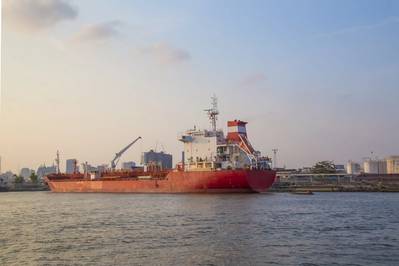In 2017, global ton-mile demand to transport crude and residual fuels increased by 5.4 percent, supported by a 4.9 percent increase in VLCCs (which accounted for 62 percent of the total demand for dirty tankers), according to McQuilling Services’ 2018-2022 Tanker Market Outlook report. Suezmax demand meanwhile accounted for 24 percent of all DPP demand in 2017, 1 percent higher than 2016 due to higher crude exports from the Southern Europe and North Africa load region towards the Asian refinery complex.
In examining bilateral country trade flow data, McQuilling recorded a 2.1 percent rise in CPP ton-mile demand distributed across the four tanker segments it analyzes. At 2.23 trillion tonmiles, CPP marine transportation requirements make up 17.3 percent of all tanker demand, the highest on record.
For 2017, McQuilling estimates that LR1 transport demand declined by 2.4 percent, following a 3 percent rise in 2016. With the estimated amount of transported tons remaining stable year-on-year at around 119 million, the reason for the tonmile contraction can be explained by a reduction in mileage from 3,703 miles per voyage to 3,618.
Throughout 2017, McQuilling recorded 145 dirty vessels delivered to the fleet, an acceleration of deliveries when compared to the 101 ships observed in 2016. The Suezmax sector expanded significantly with a net fleet growth of 45 ships. On the clean side, McQuilling observed a similar trend with vessels additions rising from 55 in 2016 to 71 in 2017. Additionally, McQuilling also observed 60 MR chemical tankers join the fleet.
Vessel deletions totaled 91 ships in 2017, 64 from the dirty side and 27 from the clean side. About half the removals were dedicated to the VLCC and Aframax sectors with 24 and 25 vessels removed, respectively. In the clean space, McQuilling observed 27 deletions with the majority in the MR space at 21 vessels, while four LR2s and two LR1s were removed.
Newbuilding ordering activity rose 64 percent year-on-year in 2017 within the DPP sector amid much higher interest in the VLCC and Aframax segments. In 2016, 19 VLCCs were placed on order, which rose to 51 in 2017. Suezmax and Aframax orders also increased rising to 23 and 34 newbuilding contracts, respectively. Clean tanker ordering activity through 2017 represents a decline in comparison to the previous five years with 16 LR2s and five LR1s contracted. In the MR2 space, 67 percent of orders were chemical tankers, while in the handysize segment, owners increased this percentage to an absolute 100 percent, the first year this has occurred.
Looking Forward
Global economic activity strengthened in 2017, following a year of the weakest growth since the financial crisis at 3.2 percent in 2016. According to the International Monetary Fund, global growth is on track to expand 3.7 percent in 2018, an upward revision from previous expectations.
Global crude demand is expected to rise by 840,000 b/d in 2018 amid significant growth in the East on the back of expanding refinery capacity. Global crude supply is projected to rise by 1.5 million b/d in 2018, despite continued efforts from OPEC and non-OPEC countries to rebalance the markets and normalize inventory levels. Crude and residual fuel ton-mile demand is projected to increase by about 1 percent on an annual basis throughout the forecast period with a decelerating trend observed in the outer years of our forecast. McQuilling projects 2018 demand growth of 1.8 percent supported by higher long-haul West to East crude flows, particularly out of the U.S. Gulf, Brazil and Europe with pressure on demand continuing from reduced Middle East flows to the U.S.
McQuilling projects a net fleet growth of 155 dirty ships through 2022 on the back of 591 deliveries and 436 deletions. Substantial growth of about 72 vessels is forecast for the VLCC fleet, while the Panamax fleet is on track to contract over our forecast period, as owners place emphasis on coated tankers of this size. On the clean side, McQuilling expects a net fleet growth of 56 vessels over our forecast period as the LR fleet expands, while the MR CPP fleet contracts; however, McQuilling notes that the MR chemical fleet will continue to grow over this period.
On the basis of supply side pressure as well as demand indicators pointing to decelerating growth, McQuilling expects 2018 to be a weak year for rates of all dirty tanker classes with VLCCs averaging around $21,700/day and Suezmaxes averaging $12,100/day.
The story is quite different on the clean side of the market as supply fundamentals improve with growing demand. Spot market earnings in the LR2 and LR1 sectors are projected to average around $14,600/day and $13,100 in 2018, respectively. MR earnings on a roundtrip basis are, in general, expected to rise in 2018 with TC2 TCEs averaging $8,800/day; however, higher earnings of $14,900/day can be attained on the basis of the Atlantic Basin triangulation. Potential for supply side pressure on clean freight rates becomes evident in 2020 based on analysis of McQuilling’s new long-term delivery forecast methodology.
McQuilling’s 2018 price forecast for the five-year old crude tanker sectors sees VLCC values averaging $62.6 million, a 3.5 percent increase from the 2017 average price of $60.5 million. Modern Suezmax tankers are projected to demand $41.2 million in 2018; however, by 2022 McQuilling projects the values of these tankers to reach $51.2 million amid a pickup in earnings.
Clean tankers of this age group (five-year) are expected to see higher prices relative to their 2017 averages. For the LR2 space, McQuilling forecasts a 2018 average price of $37.1 million, a 5 percent increase from the average price recorded in 2017, while the LR1 sector is expected to see gains of 11 percent year-on-year to average $31.2 million. The MR2 tanker is likely to appreciate 15 percent to $27.1 million.














